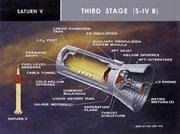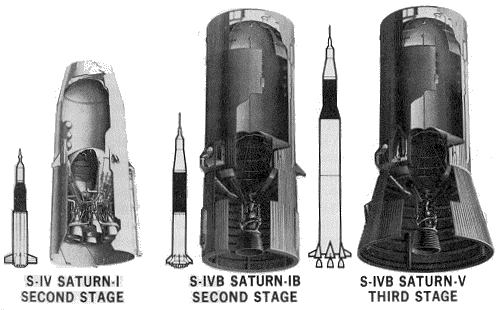S-IVB
|
|
| Missing image Saturn_IB_S-IVB-206.jpg S-IVB-206 which was used for the Skylab 2 flight | |
| Fact sheet | |
|---|---|
| Height | 17.8 m (58.4 ft) |
| Diameter | 6.6 m (21.7 ft) |
| Mass | 119,900 kg (253,000 lb) |
| Engines | 1 J-2 engines |
| Thrust | 1,001 kN (225,000 lbf) |
| Fuel | liquid hydrogen and liquid oxygen |
The S-IVB (sometimes S4b) was built by the Douglas Aircraft Company and served as the third stage on the Saturn V and second stage on the Saturn IB. It had one J-2 engine. For lunar mission it was used twice: first for the orbit insertion after second stage cutoff, and then for the trans lunar injection (TLI) when the timing was right.
History
The S-IVB evolved from the upper stage of the Saturn I rocket, the S-IV, and was the first stage of the Saturn V to be designed. The S-IV used a cluster of six engines but used the same fuels as the S-IVB - LH2 and LOX. It was also orginally meant to be the fourth stage of a planned rocket called the C-4, hence the name S-IV.
Eleven companies submitted proposals for being the lead contractor on the stage by the deadline of 29 February, 1960. NASA administrator T. Keith Glennan decided on 19 April that Douglas Aircraft Company would be awarded the contract. Convair had come a close second but Glennan did not want to monopolise the liquid hydrogen fuelled rocket market as Convair was already building the Centaur rocket stage
In the end the Marshall Space Flight Center decided to use the C-5 rocket (later called the Saturn V), which had three stages and would be topped with an uprated S-IV called the S-IVB which instead of using a cluster of engines would have a single J-2 engine. Douglas was awarded the contract for the S-IVB basically because of the similarities between it and the S-IV. At the same time it was decided to create the C-IB rocket (Saturn IB) that would also use the S-IVB as its second stage and could be used for testing the Apollo spacecraft in Earth orbit.
Douglas built two distinct versions of the S-IVB, the 200 series and the 500 series. The 200 series was used by the Saturn IB and differed from the 500 in the fact that it did not have a flared interstage and had less helium pressurisation onboard as it would not be restarted.
The S-IVB carried 72,700 liters (20,000 U.S. gallons) of LOX and 229,000 liters (63,000 U.S. gallons) of LH2.
An un-used S-IVB provided the hull for Skylab, the United States' first space station.
During Apollo 13, Apollo 14, Apollo 15, Apollo 16 and Apollo 17, the S-IVB was crashed into the Moon in order to perform seismic measurement used for characterizing the lunar core.
Stages Built
| 200 Series | |||
|---|---|---|---|
| Serial number | Use | Launch date | Current location |
| S-IVB-S | "Battleship" static test stage | ||
| S-IVB-F | Test stage for the facilities | ||
| S-IVB-D | "Dynamic" test stage delivered to Marshall Space Flight Center in 1965 | U.S. Space & Rocket Center, Huntsville, Alabama | |
| S-IVB-T | Cancelled December 1964 | ||
| S-IVB-201 | AS-201 | February 26, 1966 | |
| S-IVB-202 | AS-202 | August 25, 1966 | |
| S-IVB-203 | AS-203 | July 5, 1966 | |
| S-IVB-204 | Apollo 5 | January 22, 1968 | |
| S-IVB-205 | Apollo 7 | October 11, 1968 | |
| S-IVB-206 | Skylab 2 | May 25, 1973 | |
| S-IVB-207 | Skylab 3 | July 28, 1973 | |
| S-IVB-208 | Skylab 4 | November 16, 1973 | |
| S-IVB-209 | Skylab rescue vehicle | Kennedy Space Center | |
| S-IVB-210 | Apollo Soyuz Test Project | July 15, 1975 | |
| S-IVB-211 | Unused | U.S. Space & Rocket Center, Huntsville, Alabama | |
| S-IVB-212 | Converted to Skylab | May 14, 1973 | |
| 500 Series | |||
| Serial number | Use | Launch date | Current location |
| S-IVB-501 | Apollo 4 | November 9, 1967 | |
| S-IVB-502 | Apollo 6 | April 4, 1968 | |
| S-IVB-503 | Destroyed during testing | ||
| S-IVB-503N | Apollo 8 | December 21, 1968 | Solar orbit |
| S-IVB-504 | Apollo 9 | March 3, 1969 | Solar orbit |
| S-IVB-505 | Apollo 10 | May 18, 1969 | Solar orbit |
| S-IVB-506 | Apollo 11 | July 16, 1969 | Solar orbit |
| S-IVB-507 | Apollo 12 | November 14, 1969 | Solar orbit; Was discovered as an asteroid in 2002 and given the designation J002E3 |
| S-IVB-508 | Apollo 13 | April 11, 1970 | Lunar surface* |
| S-IVB-509 | Apollo 14 | January 31, 1971 | Lunar surface* |
| S-IVB-510 | Apollo 15 | July 26, 1971 | Lunar surface* |
| S-IVB-511 | Apollo 16 | April 16, 1972 | Lunar surface* |
| S-IVB-512 | Apollo 17 | December 7, 1972 | Lunar surface* |
| S-IVB-513 | Unused | Johnson Space Center | |
| S-IVB-514 | Unused | Kennedy Space Center | |
| S-IVB-515 | Converted for use as backup Skylab | National Air and Space Museum | |
(* See List of artificial objects on the Moon for location.)


